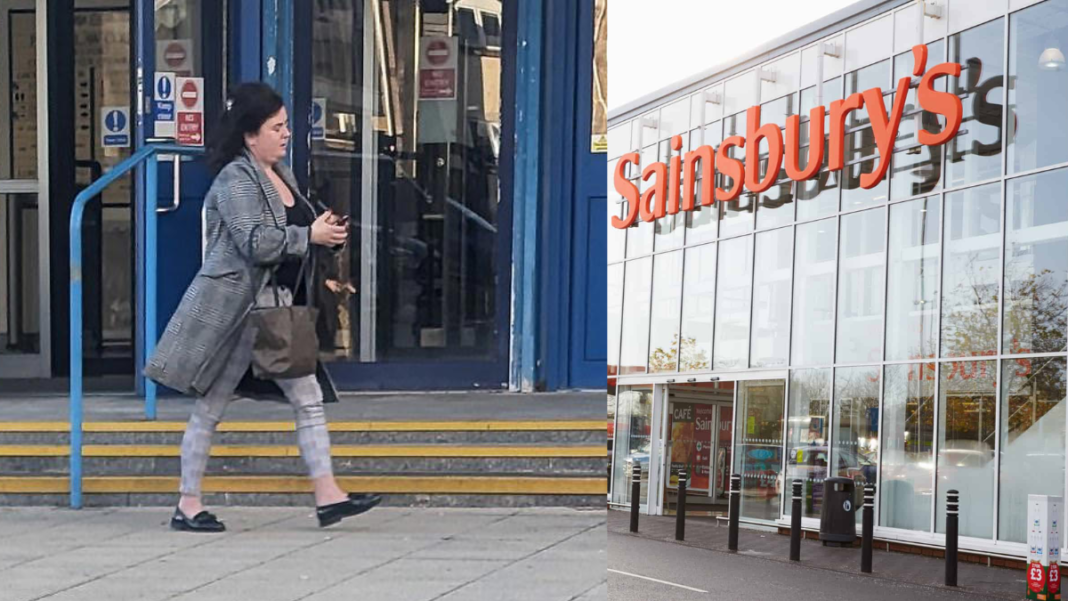Holly Trevillion, a former Sainsbury’s employee, used her antique uniform to shoplift from the grocery store chain. She made 5 separate journeys to a Sainsbury’s keep in Castlepoint, Bournemouth, where she changed into no longer acknowledged, and crammed a trolley with groceries, pretending to be an worker satisfying on line orders. On four occasions, she walked out with up to £200 well worth of goods without being stopped.
Trevillion, who had labored for Sainsbury’s for 10 years, become subsequently stuck while a team of workers member have become suspicious. She admitted to 5 counts of fraud by using fake illustration.
Introduction To Holly Trevillion’s Case
Holly Trevillion’s case is a perplexing blend of audacity and ingenuity, revealing the lengths to which some individuals will go to circumvent societal norms and legal boundaries. Known for her seemingly ordinary demeanor, Holly managed to shock her community when it was discovered that she had been engaging in a series of shoplifting incidents, cleverly disguised by wearing various uniforms. This method allowed her to blend seamlessly into different environments, exploiting the trust that uniforms often engender.
The intrigue surrounding Holly’s actions stems not only from the crimes themselves but also from the psychological and sociological implications they carry. Uniforms typically symbolize authority, professionalism, and trustworthiness—an ironic choice for someone engaged in deceitful activities. Holly’s strategic use of such attire raises questions about identity, perception, and the ease with which visual cues can manipulate human judgment.
In dissecting Holly Trevillion’s case, one must consider the broader context of why she chose this particular method and how it reflects on contemporary issues of security and trust within retail environments. The case also prompts an examination of personal motivations—was this a matter of financial desperation, thrill-seeking behavior, or something else entirely? By delving into these facets, we gain insight not only into Holly herself but also into the vulnerabilities inherent in systems designed to protect against such exploits.
Through understanding Holly Trevillion’s unconventional approach to shoplifting, we are compelled to rethink our assumptions about appearance and behavior—a reminder that even the most unassuming individuals can harbor unexpected intentions.
Background: Who Is Holly Trevillion?
Holly Trevillion is a name that has recently captured public attention, albeit for all the wrong reasons. A woman of unassuming presence, Holly was not well-known outside her immediate circle until her actions thrust her into the spotlight. Born and raised in a quiet suburban neighborhood, she led what many would consider a relatively normal life. She attended local schools and was known among friends and family as dependable if somewhat reserved.
In her early twenties, Holly held down several jobs in retail and customer service sectors. Those who worked alongside her described her as diligent but private, rarely sharing much about her personal life or aspirations. Despite this outward appearance of normalcy, there were signs that all was not well beneath the surface. Financial difficulties plagued Holly’s young adulthood; mounting debts and an unstable job market made it difficult for her to find solid ground.
These pressures perhaps contributed to the choices that would later define Holly’s public persona. Desperation can drive people to extreme measures, and it appears this may have been the case for Holly Trevillion when she resorted to shoplifting. What made her case particularly shocking was the method she employed: wearing uniforms—often associated with respectability—to carry out thefts in broad daylight.
This juxtaposition between Holly’s seemingly ordinary background and her audacious criminal activities has left many puzzled, raising questions about what truly motivates individuals to take such drastic steps when faced with adversity.
The Incident: Shoplifting In Uniform
On a seemingly ordinary afternoon, Holly Trevillion, a young woman known for her composed demeanor and diligent work ethic, entered a local department store. Clad in her distinctive work uniform, which bore the emblem of her reputable employer, she appeared to be stopping by on an errand or perhaps to pick up a few personal items after her shift. What transpired next would leave both the store staff and onlookers astounded.
Holly moved through the aisles with practiced ease, selecting various items and placing them into her shopping basket. To any casual observer, she was just another customer going about her day. However, as she approached the self-checkout stations, something unusual occurred. Instead of scanning all of the items in her possession, Holly discreetly slipped several high-value products into her bag without paying for them.

Her actions did not go unnoticed. The store’s advanced security systems quickly flagged the suspicious activity, and within moments, loss prevention officers were alerted. They approached Holly as she attempted to exit the premises. Confronted with undeniable evidence of theft—both from surveillance footage and unscanned merchandise in her bag—Holly’s demeanor shifted from calm nonchalance to visible distress. The irony of someone committing theft while dressed in their professional attire was not lost on anyone involved.
Her uniform symbolized responsibility and trustworthiness—a stark contrast to the dishonesty she displayed that day. This incident not only tarnished Holly’s reputation but also raised questions about what could drive someone entrusted with such responsibilities to engage in criminal behavior so brazenly.
The Investigation And Arrest
The investigation into Holly Trevillion’s shoplifting activities began when several high-end retail stores in the city reported an unusual pattern of thefts. These incidents had a common thread: each time, surveillance footage captured a woman in a nondescript uniform, blending seamlessly with store employees. This clever disguise allowed her to move about undetected, raising minimal suspicion among staff and security personnel.
Local law enforcement officials initiated a detailed review of the available footage and quickly noted the recurring presence of Trevillion at multiple locations. Her methodical approach suggested she had studied store layouts and employee routines extensively, indicating premeditation rather than opportunistic theft. Detectives also interviewed store employees who recalled fleeting interactions with Trevillion but failed to recognize her as an outsider due to her convincing attire.
As the investigation progressed, police collaborated with loss prevention teams from various stores to enhance their surveillance measures. They installed additional cameras and employed plainclothes officers to monitor potential suspects more closely. The breakthrough came when an astute officer noticed Trevillion entering a boutique while wearing yet another variation of the uniform that had become her signature. Acting swiftly on this lead, officers apprehended Trevillion as she attempted to leave the store with stolen merchandise concealed within her clothing.
During questioning, she confessed to multiple counts of shoplifting across several establishments. The arrest not only brought an end to her spree but also highlighted the need for enhanced vigilance against such sophisticated schemes in retail environments.
Public And Legal Reactions
When news broke about Holly Trevillion’s use of a uniform to facilitate shoplifting, public and legal reactions were swift and severe. The revelation that someone would exploit the inherent trust associated with uniforms to commit crimes struck a nerve with many. Public sentiment was overwhelmingly negative, driven by widespread media coverage that painted Trevillion as both cunning and morally bankrupt. Social media platforms buzzed with outrage, as individuals expressed their disbelief and condemnation in equal measure.
The uniform, often seen as a symbol of professionalism and trustworthiness, was suddenly tainted by this act of deception. Retail workers voiced their concerns about the potential for increased scrutiny from both employers and customers, fearing that Trevillion’s actions might erode the general public’s trust in those who wear uniforms as part of their daily roles.
Legally, Trevillion faced significant repercussions. Authorities wasted no time in apprehending her once the evidence came to light. The legal system moved quickly to set an example, underscoring that such breaches of trust would not be tolerated. Prosecutors highlighted how Trevillion’s actions were not merely theft but a calculated abuse of societal norms designed to protect honest workers.
In courtrooms and communities alike, discussions turned toward preventive measures—how stores could better safeguard against such tactics and what broader implications this case might have for workplace policies regarding uniforms. Overall, Holly Trevillion’s case served as a cautionary tale about the far-reaching impacts of abusing symbols of trust for criminal gain.
Lessons Learned And Preventative Measures
The case of Holly Trevillion, who donned a uniform to facilitate her shoplifting activities, underscores several critical lessons and preventative measures for both retailers and society at large. First and foremost, it highlights the importance of vigilance and skepticism in security protocols. The assumption that individuals in uniforms are inherently trustworthy can be a significant vulnerability. Retailers should ensure that their security staff are trained to look beyond appearances and monitor behavior patterns meticulously.
Additionally, this incident sheds light on the necessity of robust internal communication systems within stores. Employees need to be encouraged to report any suspicious activities or inconsistencies they observe, regardless of the perceived credibility of the individual involved. An open channel for reporting can act as an early warning system and deter potential thefts.
From a societal perspective, this case serves as a reminder that criminal behavior can manifest in unexpected ways. Community awareness programs can help educate the public about the various methods used by shoplifters, fostering a more alert and responsive environment.
Moreover, employing advanced technological solutions such as surveillance cameras with facial recognition capabilities can significantly enhance theft prevention efforts. These systems not only act as deterrents but also provide valuable evidence in case of incidents.
In conclusion, while Holly Trevillion’s actions exploited certain weaknesses in retail security measures, they also offer an opportunity for reflection and improvement. By adopting comprehensive training programs, encouraging proactive communication among staff, leveraging technology, and promoting community awareness, retailers can create more secure shopping environments and reduce the likelihood of similar incidents occurring in the future






